#outlining method
Note
Hi!
so outlining with the Shopping List outline is surprisingly fun and simple? The first story I tried it on it was a little difficult (but I think that’s due to structural issues with the draft I previously wrote for it and was outlining from memory). But the second story idea it worked great and I have had the breakthrough that I’ve been trying to have for years :)
Thank you so much
I'm glad that worked out well for you!
Needless to say, outlining in general isn't necessarily for everybody. But I feel strongly that it's had more bad press than it deserves, and ought to be routinely available as part of the writer's toolkit.
Sometimes, making a list and following it just seems to work best. And the technique C. J. Cherryh gave me has worked well for decades now. So other folks may as well give it a try too, and see if it does anything for them... :)
206 notes
·
View notes
Text
3 notes
·
View notes
Text
THE BEHEADED VRCHAT AVATAR IS NOW COMPLETE AND AVAILABLE ON ALL PLATFORMS!
now features a friend! :)
link is in the replies!
#dead cells#vrchat#serenade is less dynamic on the quest version but it is still there!! just follows at a fixed position; can't be held; & has no text or sfx#also please let me know if i need to use a different method to share avatars because i have no idea if the vrc website works :'D#i literally cannot find anyone talking about it at all whatsoever even though it looks to be functional so i am. very confused about it#my trust rank isn't high enough to upload worlds publicly so idk what my options are exactly :')#(also i forgot to add a sfx toggle whoops. i'll do an update for that later but i wanna actually get this posted)#edit: just realized serenade's materials are BROKEN THE OUTLINES ARE GONE AUGH#that will also be fixed when i do the aforementioned update lol#pain and misery etc (i actually love doing this but things go wrong So Much lmao)#edit 2: updated with sound toggle and fixed outlines woo!
82 notes
·
View notes
Text
I did a vine theme for pumpkin carving this year. A pumpkin pumpkin and a rose pumpkin.




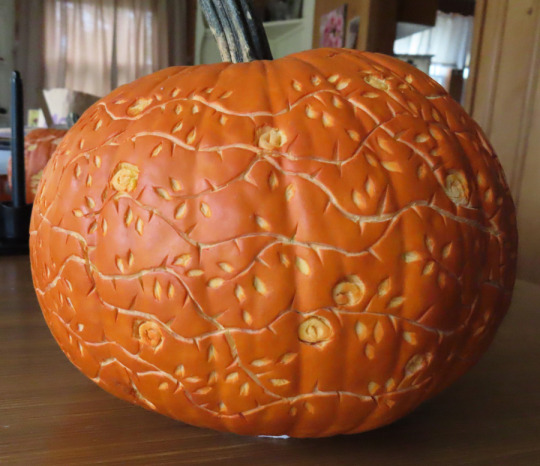


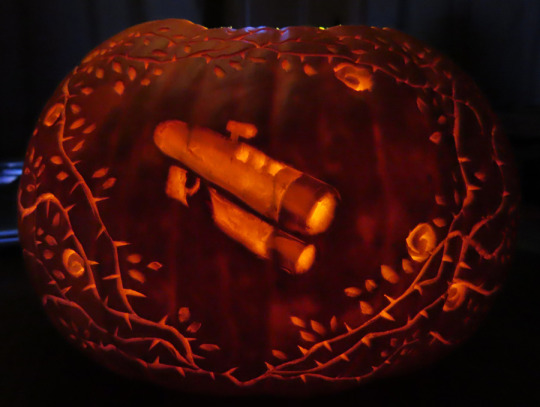
I'd made a poll asking whether to do vines or draw Dan and Valerie from Danny Phantom, or both. ...And although 'vines' won, the idea of adding something Dan and Val related was too compelling. The thought of deep red roses with their thorns being like Valerie. ...And, well, I suppose Dan's like a big heavy pumpkin being thrown at stuff?
I tried making the plants wrap around an object representing them, Dan in a D shape and Valerie in a triangle shape. Though it's not very noticeable.
#pumpkin#jack o lantern#halloween#vines#roses#danny phantom#dan phantom#valerie gray#asj post#asj art#the Valerie one turned out better. It was the second one I did. I changed methods a little for it.#oops. I got the trigger for Valerie's multi-weapon wrong. I should've checked.#(the weapon was once misidentified as her Ecto-Grenade Launcher; but that's actually a different weapon.)#I also thought the way pumpkin flowers are oddly brighter in the center might give a ghostly look. Though I hadn't carved them very well.#I would've gone about it differently if that had been the second pumpkin. I'm always too nervous during my first pumpkins.#These are the largest pie pumpkins I've bought so far. They're a little bigger than two years ago and a lot bigger than last year.#They're 25 and 24 inches in circumference.#...It took a day and a half to carve each one.#The 1st pumpkin I scraped out the vines. But for the 2nd one I did a vector technique on the vines and leaves where I drew outlines & dug.#...I still think pumpkins aren't really vines but it's simpler to say that as a shorthand for 'climbing plant'.#I might add some alternate views in a reblog later.
48 notes
·
View notes
Text
paper due in 27 hrs no figures made outline yet unfinished and dopamine levels are at ZERO i may lie back and sink down into the burning center of the earth as my skeleton is crushed by pressure unimaginable
#why! can’t! i do any of the things I need to do!#i need to go over some paper abstracts and I need to write my outlined methods section. but my brain is so understimulated it won’t let me!#willow’s life#sorry for complaining two days in a row I’m just. losing it#this project has been a disaster from the beginning and the only problems that’s even semi my fault is that I didn’t work on it last week
33 notes
·
View notes
Text
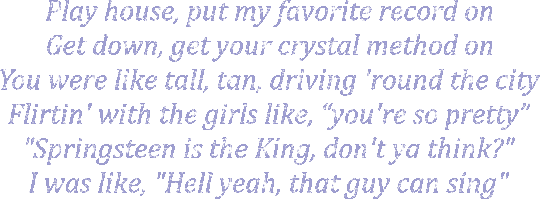
American • Lana Del Rey
#lana del rey#lana lyrics#glitter text#gif warning#lyrics#bloggif.com#no outline#get your crystal method on#cambria italic#cambria font#50px#album: paradise#American ldr
4 notes
·
View notes
Text
teachers I love and appreciate when you incorporate project work into class time so no one gets left behind or confused, however if I have to write my essay following this specific format I WILL explode and die. loudly. right now
#shitpost#like it's a great structure i'm so so glad you do it that's great#however my brain is going to implode trying to make it work in these structures#i don't do thesis building like this#all these fuckingn steps to essay outlining#i have my own methods#tried and true to work for me for several years#this is just. this is 90% wasting time for me </3
10 notes
·
View notes
Text
project update!! check it out!!
this is a basic draft, every planet outlined and colored so I know where things go so I can remove the tracing material


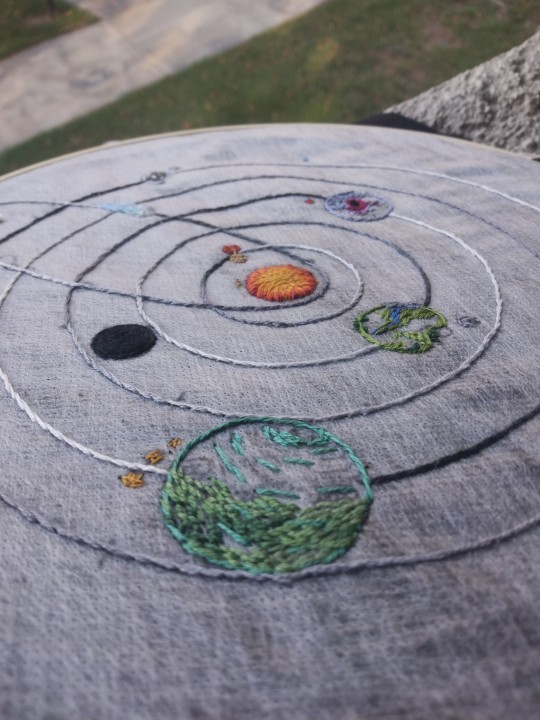
and here it is with the tracing material removed!!
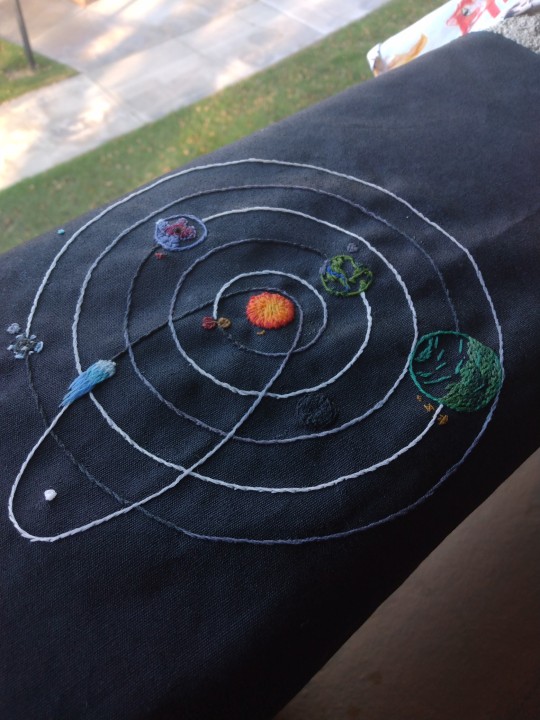
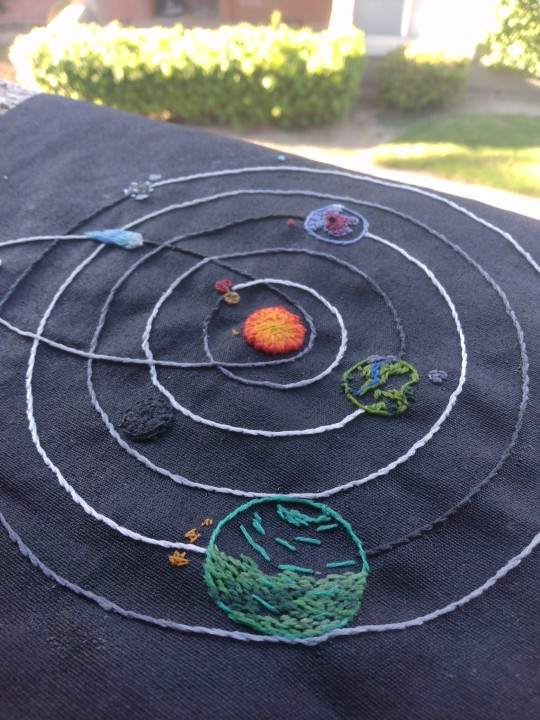
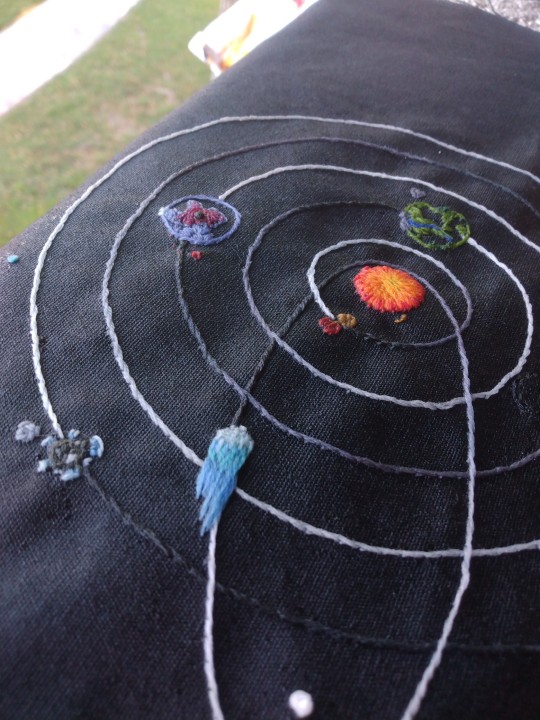
it's over halfway done and it looks so GOOD on the solid black I'm so relieved!!
#kennart#wip#outer wilds#textiles#i should have a proper embroidery projects tag tho yknow#its still wet and drying (that tracing material is water soluble)#so it might just be because it's wet BUT the stranger actually disappeared really nicely?? im so relieved???#i accidentally messed up the black hole on brittle hollow so i'm trying to figure out what i'm gonna do about that#looking forward to filling in giant's deep tho - theres no weird tricks to that so its methodical and relaxing#and when all the planets are done i'm gonna do the starfield!#i have one test little blue nova you can see there between dark bramble and brittle hollow#ALSO the basic outlining i did for dark bramble looked very meh before i removed the tracing material#but against that dark black it actually looks?? pretty much done?? up close you can tell it needs work but from a distance nah??#anyway im loving how this is turning out. worth be almost busting up my hand last week
119 notes
·
View notes
Text
Have I proselytised lately about My New Best Friend, Outlining? I feel like I haven’t done enough proselytising lately about My New Best Friend, Outlining.
#i resisted SO hard for SO long 'i'm a pantser! okay a plantser! I have to go where the story takes me! i can't know it ahead of time >#< it'll kill my excitement and I'll never get it finished!' bestie you weren't ever getting it finished ANYWAY#and you know what? figuring out a method of outlining that really worked for me#(which has largely ended up being. 'write down every cool idea you want to include and the ending you want to reach >#< then put them in order and figure out how to get between them by working backward and forward until you meet in the Dreaded Middle')#has actually only INCREASED my excitement about my writing projects! because now I Know I'm not going to get bogged down#staring at the looming Dreaded Middle coming up faster and faster in the windshield and having no idea how I'm gonna deal with it#when it gets here#honestly now that I'm outlining things I'm actually finishing MORE things and more quickly than I ever did when I refused to outline!#anyway this post brought to you by me ironing out a few of the last remaining wrinkles in the outline for former heroes#AND making a heck of a lot of headway on an actual outline for the ageswap fic#that's RIGHT the ageswap fic has an OUTLINE now and might actually get FINISHED#writing
39 notes
·
View notes
Photo
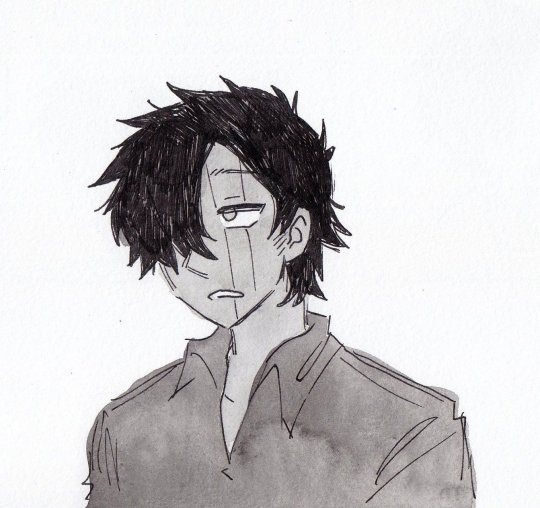
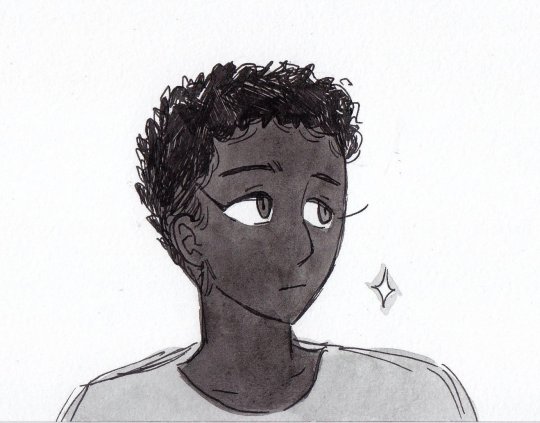
TRYING out actually using my ink for the black sections like hair in my art like a normal cartoonist for once but i was too lazy to actually bust out ink and a brush or even just a thick marker so i scribbled it with my fine tip drawing pen instead HDJSKDHKJDS
#art#traditional art#watercolour#oc art#ocs#oc group: lia crystal darling#oc: bibi#oc: lia#i love drawing eyebrows and eyes all the way in the forehead and bangs and hairline but with black hair thats TRICKY cause u cant SEE IT#but if i am more careful with my hairline and bang placement or if i try the 2008 furry mspaint animator on youtube method of adding#white outlines in the black parts to show eyebrows etc etc it might be viable. what do they call it in the industry? filling in blacks?#filling in the blacks with actual black instead of trying a really really dark gray can be more efficient with b&w drawing for print it seem#so im fudging around with art style shenanigans. its always good to do that. test out different ways to draw to see what feels good#good way to stave off art block too. thats why ive suddenly started drawing eyelids HJKLFDSKJFDSL it might not stay in my art forever#but rn. were in eyelid world
9 notes
·
View notes
Note
What would have happened in My Sweet Honey? I really liked it back in the day
ahhh sorry I stopped updating it! I dont want to say exactly because maybe one day I'll revisit it but roughly they'll have conflict due to kale's insensitivity,, but eventually live happily ever after 💕
#i feel bad about leaving it but i felt i outgrew it and had more mature stories i wanted to work on#i had a whole outline though of the plot i had a plan but it was also the first comic i ever made so my method of organization was madness#thank you for reading it 💕#im working on a vampire comic rn that i need to finish for may#perhaps late 2024 or even 2025 ill get the urge to complete msh ill have to see
4 notes
·
View notes
Note
This definitely helps a lot, I have to try it or adapt it to myself. Thank you so much. I want to take advantage and ask you, as a writer you are, some advice for writing your drafts and dialogues clearly. I mean, I usually write a paragraph describing what happens at each moment, but I think it is a fairly orthodox method.
Shore ting. Rough drafts and the sort are probably the easiest to get done - if you've seen the post that tells you cold turkey.
Just write the damn thing. Tell YOURSELF the story, write out what needs to be said. You want to get the descriptions, story elements, dialogue - all down. Especially when you have a tight schedule and not a lot of work time.
Drafts can benefit from a good, organized outline - or an Outline that stacks out events, scenes, and the rough dialogue content. If you're still working on specifics to your story, or you have the setting and environment firmly fixed in your brain, but you're struggling with the dialogue. Anything. And an outline can be as complex as you want it, maybe you'll write out a very detailed paragraph that you'll implant into the story itself because it was written and hit all the nuances and descriptions you needed. The same goes for dialogue - You might have brief sentences describing the scene at its bare bones, but go ham entirely on this dialogue interaction and get the whole thing scripted out. If you're struggling with a scene leading to that dialogue, or you have a scene rolling but you haven't decided the direction of the dialogue, inserting bare bones basics of your idea can benefit keeping that creative juice rolling.
Another big aspect of a draft is pacing. Which can be the trickiest concept when drafting or getting a story written. What scenes do you want to focus on? Why are they important? How do they progress the plot, the story themes you want to cover? Where are you taking the reader, and why? Because in story pacing can cover a day or an hours worth of time, in a few paragraphs - if it's not integral to the story. Like a movie montage. Or, if certain scenes and events are important, the character might spend an extended amount of time working through the scenes - i.e., paragraphs or chapters. But in your story, you have to incorporate the components that are important and interesting, and fulfil the readers need for rewards for the questions we have. In pacing your readers progress through the story, you're informing them of the events as they transpire, as they are important to your plot; you also need to keep the reader fixed in the environment so they know where they are, in reference to the characters. It might work in some cases to dump a lot of exposition onto the readers lap to get them up to speed, but for some it can be a turn off to have a lot of information to take in all at once. You can trust your process of writing that when you are giving the details at the right time, your reader will be enticed and follow, and will learn about the story at increments that are easy to understand. This can be essential to extensive world building projects, because the invested reader will stay involved with the work and keep absorbing details - then that becomes a process and relationship between the writer and reader, where both are undertaking a journey to learn about a realm that is entirely fabricated. The writer tells a story piece by piece, and the reader returns because there is always something to return to.
A good method for helping with elements like pacing and description details, is try taking the time to evaluate a graphic novel or any other rich story telling comic book media, like mangas and the sort. You can think of each panel incorporated into this visual novel as segments of paragraphs - even the little boxes that say something like WHAMO! because recall, a paragraph can be as long or as short, or a single word - its a tool at your disposal. A paragraph breaks up the flow of thought, it changes the perspective or anticipation of the reader - much like the graphic novel changes the 'camera' to view each scenes. The panels give to readers what is need to know at each moment, where and what a character is experiencing. Panels sometimes overlap, sometimes they are interesting shapes or wedge between two dynamic panels. That is how the visual story is being fed to the reader/observer, and it can be very similar to how we tell story with paragraphs - some brief paragraph inserts go over a characters internal thoughts, or a cluster of paragraphs in a sequence cover an extensive establishing scene where the characters will exist for an extended period of time. It's always important to recall pacing though, and how much in terms of details the reader needs to know.
This is also valuable to how incorporating dialogue works with in the story itself, and how to pace conversations with certain actions - dynamic or passive. Think how the reader should experience this dialogue, and what it will define of the characters. Even a purely dialogue scene can describe to the reader what is happening, or what the character is doing.
"I cannot tell you how irate I am with this situation. Ingrates! All of them! Wait. Why is my door locked?"
"Er, did no one deliver the notice? You've been replaced."
Without any context, this brief can determine a lot of different things. The first speaker is angry, and they are trying to get through a door - a door that they no longer have access to. The second speaker elaborates some news which the speaker was not given, which in itself could imply a lot of different situations - no one cared, there's been a disturbance in hierarchy, or the first speaker is very unpopular. But as I've said, a draft can be as complex or simple as you need it, so long as you can get the details down and get the general mood or theme you want to convey. All of this might shift as you elaborate the broader idea of your story, so it depends on what and where you want it all to go.
Show, don't tell. Give the reader freedom to experience the story, use their emotions and perceptions to internalize a scene. In some situations it is important to elaborate why a character feels a certain way, or why they undertake a certain action. If a character is being swept away in a river, the reader does not need to be told, Gabriel flung his arms from the frothing rapids seeking the bank, a branch, anything or he would drown under the merciless waves. The description feels more visceral and desperate if it's described, Gabriel flung his arms from the frothing rapids and lashed at sharp rocks, his fingernails ripped at wood and mud before he plunged beneath the foam. Both sentences convey the same stakes, are very similar in terms of the situation and what Gabriel needs to achieve, but the latter sentence does not need to elaborate why Gabriel is panicked and flailing - it's in the moment and immersive, wherein Gabriel and the reader are both fighting to find a handhold, but fail and are sent beneath the river's rapids. Rather tell the reader what Gabriel feels, I want to immerse my reader with the sensation and panic the character is enduring. At the same time, the process is a balance of what you need the reader to feel and keeping them adhered to the story as it unfolds. It is always okay to detach the reader from the character and exposition when it is helpful or necessary. Don't become so fixed with telling the perfect story, that the process ostracizes the readers capacity to relate or interpret what is happening, or why we should be invested.
I hope all this is helpful to the drafting process. A lot of this is also finding your style and voice in the narrative, how you choose to choreograph scenes and approach the plot. It factors into how you choose to assemble the general idea of the story, for the eventual scope of the character and readers journey. And all of that comes down to getting it written, not getting overwhelmed or hung up with an instant perfect process.
Again, if there are additional questions or anything I should clarify - coz this is a lot of stuff, feel free to ask. Im far from perfect when it comes to following my own rules, but I do have methods to my madness. And the whole writing process is good for experienced writers to review and share with others, since its a learning process that never ends.
#angisam#writing#writer#drafts#how to outline#script writing is good too#experiment and try different methods#this long
2 notes
·
View notes